Inspired by the curling purple petals and fringed yellow throats of violets, Wild Violet Soap is a fun way for a soap maker to celebrate the return of spring! An all-natural, cold-processed soap recipe, it is made with foraged wild violet infused herbal tea, moisturizing violet infused sweet almond oil, and tinted with natural colorants.
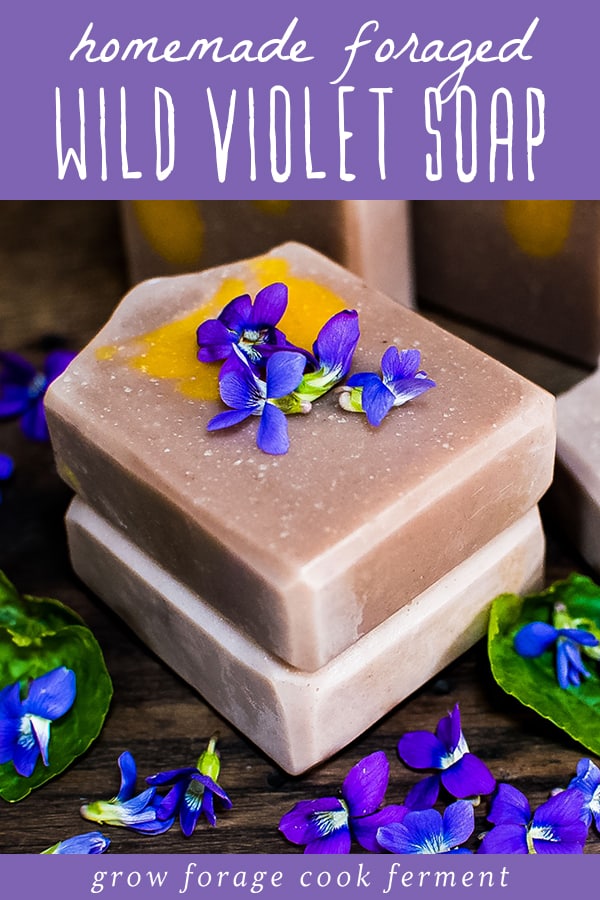
Want to save this post for later?
Wild Violets for Natural Soap Making
While you are out enjoying the renewed warmth of the sun, the sounds of returning birds and the greening of the earth be sure to forage for a few handfuls of wild violets and their leaves.
Not only can you make Wild Violet Vinegar for dressing your spring salad greens and Wild Violet Syrup to sweeten your favorite drinks, but your skin will thank you for making these moisturizing bars of violet soap.
Violets are full of vitamins and minerals, especially vitamins A, C, & E. This means they have a multitude of benefits for our skin! When used in skincare, violets are known to benefit many troublesome skin conditions.
Incorporating antioxidant-rich botanicals in your skincare is an excellent way to protect your skin from the damaging effects of the environment. The cooling nature of violets may work to soothe many inflamed skin issues.
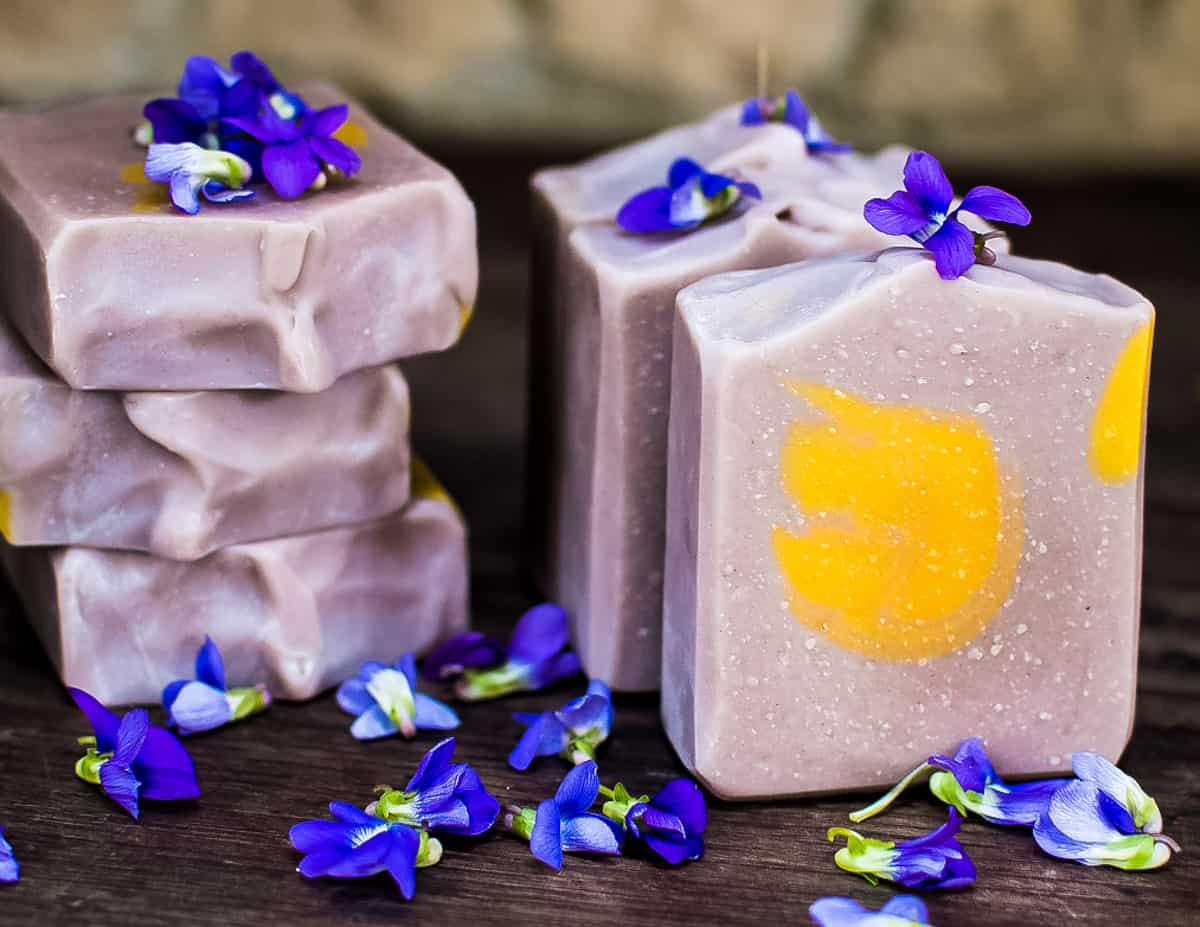
Before You Begin
New to soap making? Check out my post on how to make soap for beginners first so you know all the basics of safe soap making!
I also highly recommend Jan Berry’s Natural Soapmaking eBook and eCourse!
They are fantastic resources for beginners and include step-by-step instructions for making natural soaps, with recipes too. It’s how I learned how to make soap!
Violet Soap Ingredients
{This post is sponsored by Mountain Rose Herbs}
Mountain Rose Herbs is my favorite place to get carrier oils, dried herbs, and essential oils. Brambleberry has a good selection of natural colorants and other soapmaking supplies.
- 16 oz. purified tallow
- 7.5 oz. coconut oil
- 7.5 oz. violet infused sweet almond oil
- 11.8 oz. violet infused herbal tea
- 4.5 oz. sodium hydroxide (lye)
- 1 Tablespoon purple Brazilian clay, and/or 2 Tablespoons of alkanet infused oil
- 1 Tablespoon annatto oil, or sea buckthorn oil
- 1 ounce lavender essential oil
- .7 ounces geranium essential oil
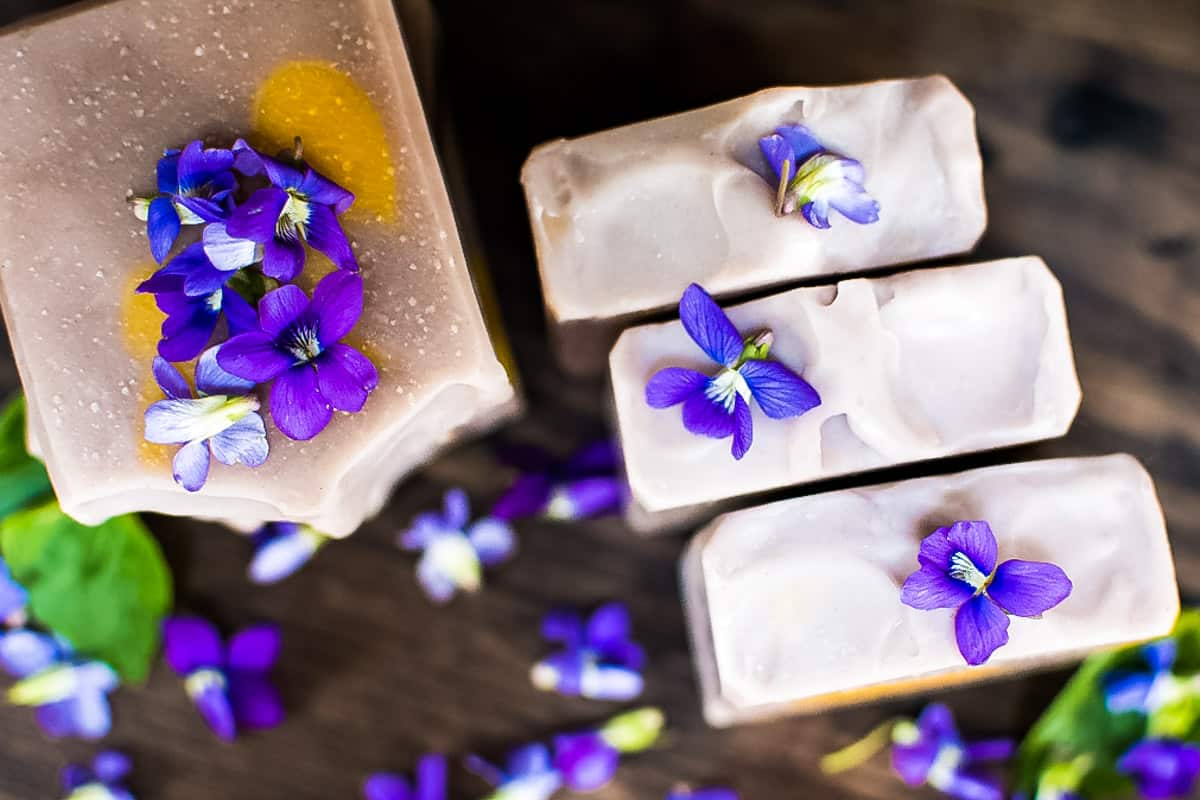
You will need to use the violets you foraged to prepare a simple violet herbal tea. Basically you just pour boiling water over the flowers and let it steep until it has cooled to room temperature.
I like to make soap with the liquid portion frozen into ice cubes. It reduces fumes and makes quick work of soap making because you don’t need to wait for the lye/water mixture to cool down.
You’ll also need to infuse the sweet almond oil with the violets. This can be either a long infusion in a cool and dark place, or a quick heated infusion depending on how much time you have.
Learn more from my article about making an herbal infused oil.
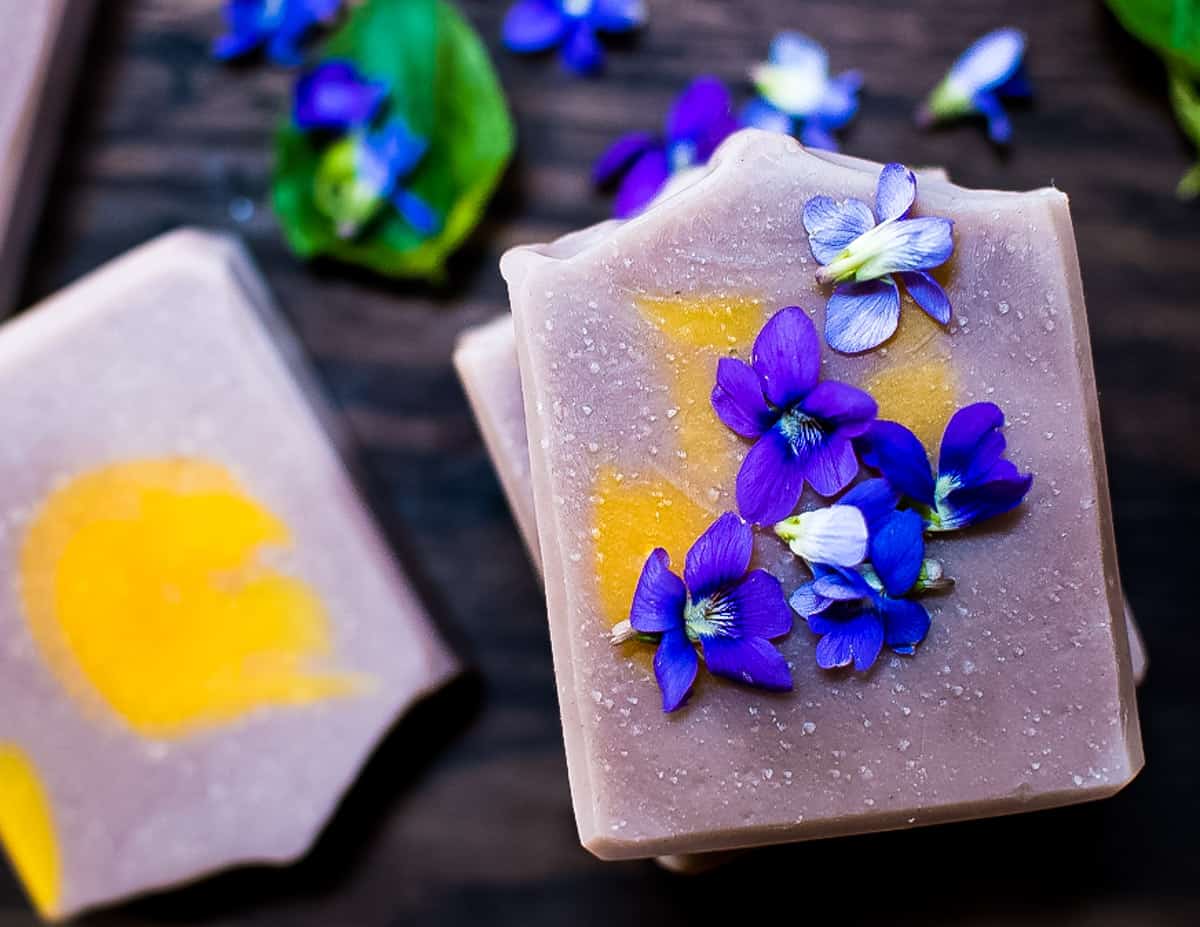
Do I Need to Use Tallow for Soap?
This recipe for violet soap is not vegan and uses tallow to make a hard, and therefore long-lasting, bar of soap. You can NOT safely make any substitutions for the tallow however you can apply the colorant techniques from this recipe to your favorite vegan soap recipe.
Not comfortable using tallow or lard in your soap? It may be in the soap you are using already! Check the ingredients list on your supermarket soap. One of the most common ingredients you’ll find is “sodium tallowate.” That’s saponified tallow.
If you are concerned about it from a sustainability standpoint, be aware that these are by-products of the meat industry and unless we find uses for them they will end up as waste. For this reason, some people choose to refrain from eating meat but still use animal fats in their soap.
You should always avoid palm oil, the most common plant-based oil used for the quality of hardness in soap recipes, due to massive deforestation during harvest.
The oils in this soap are simple and nicely balanced. As mentioned, the tallow provides hardness, while the properties in coconut oil will help it clean well, and the sweet almond oil is moisturizing and keeps the skin from drying out.
Natural Colorants for Wild Violet Soap
Brazilian clay adds extra nutrients & minerals to nourish your skin. It also provides gentle exfoliation which clears and detoxifies the skin. You’ll love the silky smooth feel of the bar because of the clay.
Purple Brazilian clay is enough to use as a colorant for this recipe alone. It will make a light dusty violet color. But I love the rich color the alkanet infused oil imparts. It will darken the shade and superfat the soap making it even more moisturizing.
You can use the purple color to make a simple violet bar or you can remove a portion of the batter before coloring and add a yellow colorant to pour over and make the yellow center.
You can use any essential oils you prefer. For this recipe, I combine lavender and geranium to give the bars an old-fashioned floral scent.
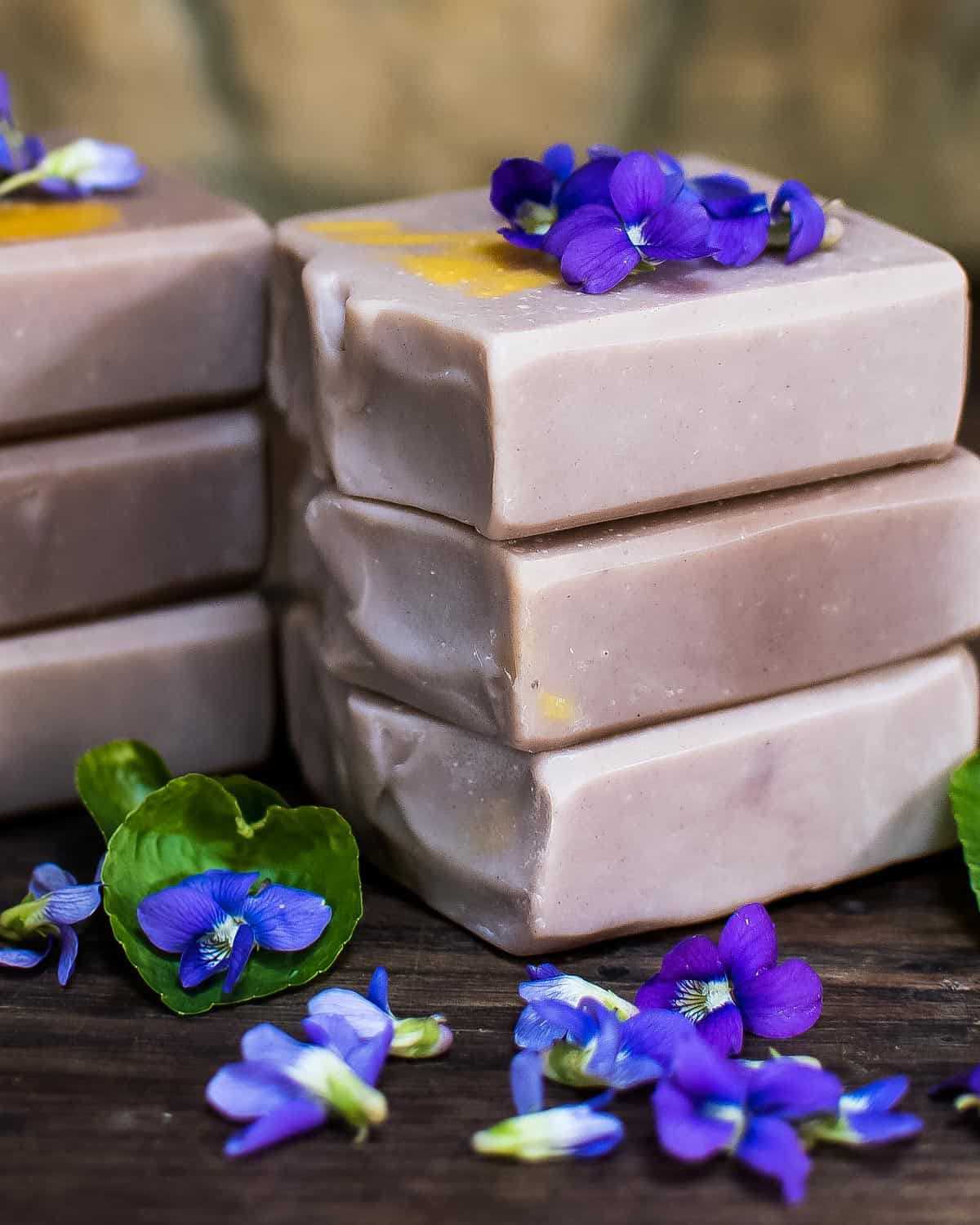
How to Make Wild Violet Soap
You’ll begin by weighing out all of the ingredients. Start with the solid fats so you can get them melting while you measure out the rest.
Weigh out the solid fats (purified tallow and coconut oil) into a large glass bowl that can fit over a small saucepan to create a double boiler. Fill the saucepan with water and bring it to a boil. Set the bowl with the tallow & coconut oil over the saucepan until they are melted.
Meanwhile, weigh the violet tea ice cubes into a large glass bowl or plastic container.
Weigh the lye (sodium hydroxide) into a small glass bowl.
Wearing your safety glasses, slowly stir the lye into the ice cubes until they are fully melted and all of the lye is dissolved.
Weigh out the violet infused sweet almond oil and stir it into the melted tallow and coconut oil blend.
Measure the essential oils and colorants into separate bowls and set them aside.
While it’s not necessary, I use a thermometer in soap making. When using cooler temperatures and harder oils I don’t want to risk false trace. By taking the baseline temperature of my soap mixture, I can be sure that trace is happening because the temperature of the batter will start to rise.
Check the temperature of the oil mixture and the lye solution to make sure they’ve cooled enough so that when mixed the temperatures will average about 90-110 degrees F.
Slowly stir the mixed oils into the lye solution and stir with a silicone spatula until the oils are incorporated and not streaky on top.
While you are stirring, take a reading of the temperature so you can get a baseline. (You know that your mixture has begun to saponify when the temperature starts rising. I like to see it go up 2-3 degrees. This is the best way to confirm you do not have a “false trace” that can happen when using oils for hardness.)
With an immersion blender, blend the mixture thoroughly until you reach a thin trace and the temperature begins to rise. Set the thermometer aside.
Stir essential oils with the spatula until they are fully incorporated and then give it another pulse for about 30 seconds with the immersion blender.
To color the soap, divide the batter as indicated in the recipe. Add the violet color to the larger quantity of batter and the yellow colorant to the smaller quantity.
It’s a quite simple technique to color the soap, yet the effect is impressive.
Fill the soap mold about ¾ of the way with most of the violet-colored batter. From high, pour the yellow batter down the center.
Gravity from the high pouring technique will drop the color towards the center. You can use a chopstick or the probe on a thermometer to give it a little swirl if you’d like. Finally, top it with the remaining violet soap batter.
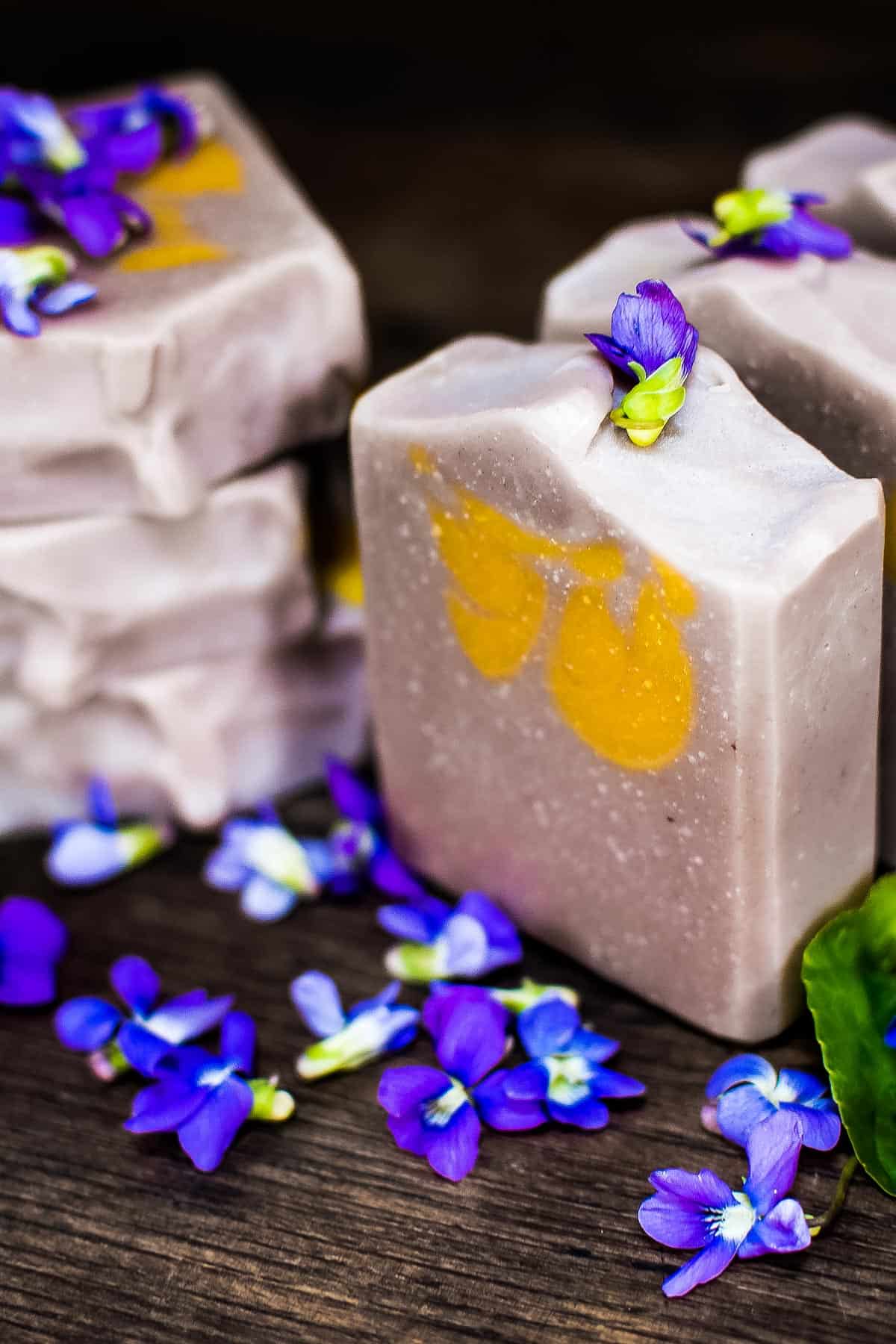
MORE NATURAL SOAP RECIPES
Here are some more soap recipes for you to make now that you know the basics:
- Rose Hip Soap
- Wild Rose and Yarrow Soap
- Kombucha Soap
- Winter Spice Pine Soap
- Dandelion Soap
- Rosemary Mint Shampoo Bars
Wild Violet Soap
Equipment
Ingredients
Violet Infused Herbal Oil
- a handful of wild violets blossoms and leaves
- 8 ounces sweet almond oil
Violet Infused Herbal Tea
- a handful of wild violets blossoms and leaves
- 12 ounces water
Wild Violet Soap
- 16 ounces purified tallow
- 7.5 ounces coconut oil
- 7.5 ounces violet infused sweet almond oil
- 11.8 ounces violet infused herbal tea
- 4.5 ounces sodium hydroxide (lye)
At trace add:
- 1 Tablespoon purple Brazilian clay
- 2 Tablespoons alkanet infused oil optional (powdered alkanet infused in oil of choice until deeply colored)
- 1 Tablespoon annatto oil or sea buckthorn oil (annatto oil is made by infusing seeds in oil of choice until deeply colored)
- 1 ounce lavender essential oil
- .7 ounces geranium essential oil
Instructions
Violet Infused Herbal Oil
- Add a handful of violet petals, and leaves if desired, to a pint sized mason jar.
- Cover the violets with about 8 ounces of sweet almond oil.
- Set the jar in a cool and dark place for a few weeks to infuse OR place it in a saucepan of water and place it on warmer burner or in a slow cooker filled part way with water on the warm setting.
- After a few hours to overnight, strain the violets from the oil.
Violet Herbal Tea
- Bring 2 1/2-3 cups of water to a boil.
- Add the violets and remove from heat.
- After it has cooled to room temperature, strain the herbs from the tea.
- Freeze the tea into ice cubes, if desired.
Violet Soap
- Weigh out the solid fats (purified tallow and coconut oil) into a large glass bowl that can fit over a small saucepan to create a double boiler.
- Fill the saucepan with water and bring it to a boil. Set the bowl with the tallow & coconut oil over the saucepan until they are melted.
- Meanwhile, weigh the violet tea ice cubes into a large glass bowl or plastic container.
- Weigh the lye into a small glass bowl.
- Wearing your safety glasses, slowly stir the lye into the ice cubes until they are fully melted and all of the lye is dissolved.
- Weigh out the Violet Infused Sweet Almond Oil and stir it into the melted tallow and coconut oil blend.
- Measure out your essential oils and colorants into separate containers and set them aside.
- Check the temperature of the oil mixture and the lye solution to make sure they’ve cooled enough so that when mixed together the temperatures will average about 90-110 degrees F.
- Slowly stir the mixed oils into the lye solution and stir with a silicone spatula until the oils are incorporated and not streaky on top.
- While you are stirring, take a reading of the temperature so you can get a baseline. (See notes above.)
- With an immersion blender, blend the mixture thoroughly until you reach a thin trace and the temperature begins to rise. Set the thermometer aside.
- Stir essential oils with the spatula until they are fully incorporated and then give it another pulse for about 30 seconds with the immersion blender.
Swirling Soap Batter
- To color the soap divide the batter.
- Measure 6 ounces soap batter into a bowl (reusing one of the oil bowls is ok.)
- Add the annatto oil (or sea buckthorn oil) and blend well.
- Measure the remaining batter, about 20 ounces, into a separate bowl.
- Add the purple Brazilian clay and alkanet oil and blend well.
- Fill the mold about 3/4 of the way with most of the violet colored batter.
- From high, pour the yellow batter down the center. Gravity from the high pouring technique will drop the color towards the center.
- Use a chopstick or the thermometer probe to swirl if you’d like.
- Fill the mold the rest of the way with remaining violet batter.
- If desired, wait until the batter has thickened enough to swirl the top with the back of a spoon.
- Cover with plastic wrap and set the mold aside in a cool place until the soap has hardened enough to remove it from the mold.
Curing the Soap
- Cut the soap into bars and allow them to sit for at least 4 weeks to cure. The longer the soap cures the harder the bars will become.
Quinn Veon handcrafts all-natural herbal & botanical soap and skin care products inspired by the farm and garden. You can follow her on Instagram @quillhavenfarm.

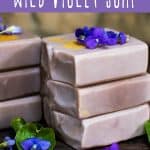
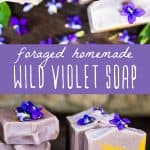
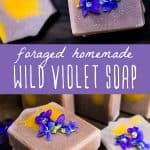
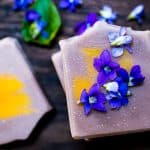

Can something other than almond oil be used? I’d like to make this safe for people with nut allergies, but don’t know what else would work.
For sure! You can use any oil you’d like. Vanilla would be nice!
Are you using almond oil to make the colorant oils? I purchased the ebook you recommend and it looks like you need to use the lye calculator depending on which oils you use to determine how fat the soap is? Thanks!
The coloring clays are not added to oils first, they are added separately. Using a lye calculator is always a good idea when making homemade soap!
Hello, do you offer your soaps for sale in your etsy store?
Thank you